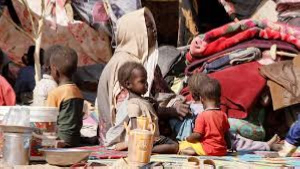The Upper East region which is the second poorest region in the country is facing health care constriants with the doctor-patient ratio at one doctor to 5,400 patients.
According to the Ghana Living Standards survey, most people in the Upper East live on less than 900, 000 cedis a year. . The regional minister Mahami Salifu disclosed this at the 'meet the press series" organised by the ministry of Information for Regional Ministers in Accra last Tuesday .
He also said the nurse-patient ratio stands at one nurse to 1531 patients in the region.
The minister also revealed that there are only 17 medical officers in the region whiles 40 doctors are required. He gave the total number of nurses in the region as 599 for all categories of nurses. "The total medical staff strength is 1335 with a shortfall of 422.
Mahami Salifu lamented that the availability of doctors and other para -medical staff in the region is woefully inadequate. He said the medical doctors and other para-medicals posted to the region simply decline the posting.
According to Salifu, the infant mortality rate stands at 82 per 1000 births in the region against the national average rate of 57 per 1000 live births..
The maternal mortality rate is between 500-800 per 100,000 live births compared with the national average figure of 214 per 100,000 live births.
In the case of HIV/AIDS, Mahami Salifu said, the number of cases seen from January to June 2002 is 138 while the cumulative number of cases from the year 1989 to date is 3,436.
Some of the reasons why doctors have refused postings to the region according to the minister, include lack of good schools for their children, lack of accommodation, lack of opportunities for private practice and negative perception about the region.
To this effect, the regional minister said the Regional Co-ordinating Council and the Health Administration of the three northen regions are looking at strategies to attract and retain medical personnel to the region .Some of the strategies include subsidising accommodation, profesional training out of town, allocation of means of transport among the rest.
According to the Minister, " despite the sorry state of affairs, some measure of success has been chalked in the health sector.
Some of these successes include the establishment of a cross border immunisation programme for the control of polio and Celebro Spinal Meningitis (CSM) with neighbouring Togo and Burkina Faso.
The regional minister said the region has eradicated guinea-worm in the communities hence less than 20 cases were recorded last year which include some imported cases. He said the District Assemblies are providing boreholes for the few areas that still lack potable water so as to prevent the return of guinea-worm and minimise cholera and other diarrhoeal diseases.
Mahami also announced that there is a disease surveillance and prompt reporting system in place in the Upper West Region
On education, the Minister said the enrolment of girls in schools is a major problem in the region. "The World Food Programme and the Catholic Relief Services provide one hot meal a day for girls in selected schools as a way of encouraging girls to attend school," the minister said adding World Vision International is encouraging the girl-child in the Bongo District by providing school uniforms to girls in school.
In the area of road network, Mahami Salifu said road construction is a key sector in the socio-economic development of the region.He said the region has about 1017 kilometres of feeder roads of which 700 km which represent 69 percent is motorable and 317 km which is 31 percent are certified to be non-maintanable.
Mahami Salifu said the region has a total of 549.8 km of trunk roads of which 31.0 km is a national road, 63.3km is inter-regional and 173.3km is regional roads.
He said as part of efforts to open up the hinterland and to facilitate the movements of goods and people, the Naga Rice Valley road, Niagnia-dam site road, Gaami to Bui road have all been awarded on contract and work is going on on these roads.
For the region's stand in agriculture, the regional minister said, about 84 percent of the Upper East Region can be described as rural while about 70 percent of the population are engaged in agriculture.
The regional minister said "poor soil fertility has been the consequence of environmental degradation which hamper sustainable agricultural practices". He added that despite the harsh ecological conditions, the region is gradually meeting her food production target due to emphasis placed on irrigation agriculture and other income generating activities being pursued and improved agricultural practices.
To make food security a reality, Salifu said, farmers are being assisted with credit to undertake other forms of income generating activities to earn extra income in addiction to farming practices.He said women form about 67% of the target group for income generating activities.
On water, the Minister explained that the Ghana Water Company currently operates three urban water supply systems in the region in Bolgatanga, Bawku East and Navrongo.
"For Bawku East, the source of water is underground water and daily production is 1000 cubic metres per day against a current demand 5,104 cubic metres per day," the minister said adding "Water is therefore rationed to customers."
Again he said Navrongo has a daily capacity of 800 cubic metres per day against a current demand of 2,877cubic metres per day.
Water Supply in Bongo is erratic because of lack of water service reservoir. Investment is required for rehabilitation and expansion of distribution network to cover supply to Winkongo, Pusu-Namogo and Pwalugu."
At the recent World Summit on Sustainable Development held in South Africa, a Ghanain Water Expert at a meeting on West Africa Water Initiative said underground water in the Bongo District has high levels of fluoride which is impacting negatively on the dental system of people in the area.
According to Dr. W. Braimah Apambire of the World Vision International, although several rural communities are faced with waer problems, the plight of the people in the Upper East Region in Northern Ghana is even worse.
This is because people there have dangerous levels of fluoride concentration in their waters.
He said while the safest concentration of fluoride is 0.7 milligrams per litre of water to build strong teeth and bones, water in the Bongo area which has a treatment plant in Gowrie in the Upper East Region has 4.6 milligrams per litre.
This he said has already manifested itself in dental problems in the area.
He said research has not been carried out to identify whether there are skeletal effects on the people as well.
Dr. Apambire who called for a holistic approach to solving the fluoride problem in northern Ghana attributed the problem to the geology of the Upper East region, which he said contains fluoride.
He said although some waters could have as high as 28 milligrams of fluoride, the problem of the Upper East Region should not be swept under the carpet.
On the security situation in the region, the regional minister noted that the causes of the perenial conflict in the region has to do with chieftancy, land dispute, and party politics. Salifu said as a result of the military and police intervention considerable peace has returned to the region.
Mahami Salifu said the region experieced low crime rate during the period under review. According to the minister most of the criminal cases reported are rape, possession of Indian hemp, possession of fire arms without authority, stealing, armed robbery and murder.
Fuel smuggling to neihgbouring countries is a major security prolem according to the regional minister. To this end the REGSEC has set up an Anti-Fuel Smuggling Task Force at both regional and district levels to track down these smugglers.
The Upper East regional minister, Mahami Salifu listed the constraints of the region as high illiteracy rate, high school drop out rate, a 2.5 percent high population growth rate, low access to health services aggravated by high incidence of diseases like malaria and, CSM high poverty rate and low financial services.
General News of Sunday, 1 December 2002
Source: Public Agenda












